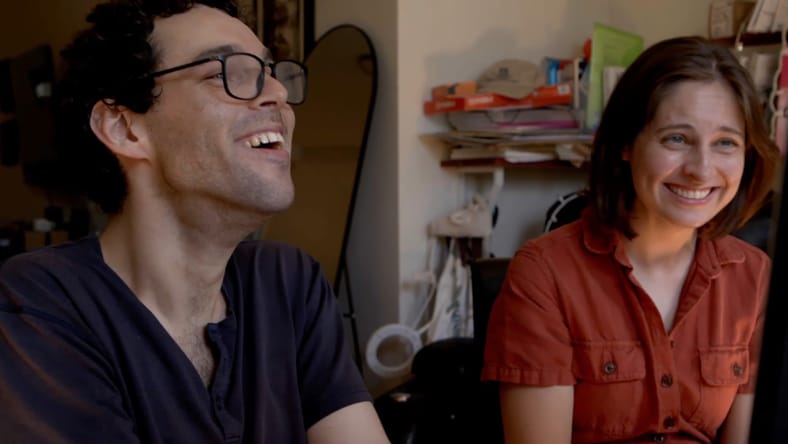
Reid Davenport is the director and Colleen Cassingham the producer of Life After, an investigative documentary about the moral dilemmas and profit motives around assisted dying. The film, which premiered at Sundance, will be released Friday at the Film Forum in New York with additional screenings to follow across the country. In this piece, Davenport and Cassingham explain how Multitude Films, where Cassingham works, enlisted a clinical psychiatrist to support and protect participants in the doc.—M.M.
Our documentary Life After exposes the ways that disabled people’s autonomy is limited by systemic failures, including poverty, barriers to healthcare, and histories of institutionalization and eugenics. The film brings together the missing voices of the disability community in the contemporary debate about assisted dying, uncovering chilling stories of disabled people dying prematurely — and challenging the idea that assisted dying always represents a free choice, when it can sometimes be seen as the only option.
Given the sensitive nature of the documentary subject and the vulnerability of our participants, it was paramount for our team to ensure we operated with care and integrity into every stage of the filmmaking process.
The relationship between filmmaker and participant is nebulous — it’s simultaneously personal, professional, and something in between. We operate on intuition and good intentions, but we’re not inherently endowed with a clear framework and guiding principles to rely on to mitigate harm and foreground care. In creating Life After, we were asking and selecting inherently vulnerable people to participate in a film, so we felt a deep sense of accountability to our participants.
Life After and Documentary Ethics
To guide us in our approach, we engaged clinical psychiatrist Dr. Kameelah Oseguera (“Dr. Kam”), head of care at Multitude Films. Dedicated to operationalizing our film team’s commitments to care, Dr. Kam is a leading expert in trauma-informed considerations and practices in documentary filmmaking. Her role is to support both the film team and the participants in navigating the ethical dilemmas and other challenges inherent in nonfiction filmmaking and the toll this can take on all parties.
During production, Dr. Kam helped us structure emotionally charged interviews with care, clarity, and anticipation for the needs and concerns of our participants. One of the perspectives we sought to include in Life After was that of a Canadian disabled or chronically ill person who considered access to Canada’s Medical Aid in Dying (MAID) in response to poverty or barriers to healthcare or accessible housing.
Also Read: Fighting, Making Friends at Camp and Selling Cookies Are Subjects of NFMLA’s Disabilities Program
Given the risks of intervening in these folks’ lives, we developed an internal rubric to help us gauge who it was safe to reach out to, upholding our guiding principle to “do no harm.” Factors considered included whether they had already spoken to the media, what stage they were at in their MAID application, and their health and financial circumstances as well as their external support system.
As we selected our participants, Dr. Kam acted as a third-party liaison, offering them care sessions before and after interviews to help them process the impact of participation as well as periodic support extended through the launch and rollout of the film.
Throughout our work with Dr. Kam, she also reminded us that ethical storytelling isn’t just about protecting others; it’s also about resourcing ourselves with foresight, confidence, and integrity. We learned from this experience that the trauma extremely vulnerable participants carry with them has the potential to challenge a mutually respectful and meaningful production.
To address this, we consciously cultivated a working environment that prioritized patience, understanding, and accommodation, without being paternalistic. Having a degree of partnership with our participants was foundational to our ability to navigate conflict in healthy ways.
As documentary filmmakers we must recognize our relationship of accountability to our participants, but Dr. Kam helped us understand that the scope of that responsibility also needs boundaries – it isn’t, and shouldn’t be, all-encompassing. Those boundaries might look different for each filmmaker, project, and participant. For us, it meant making sure the burden of care didn’t create “role strain” by falling solely on the producer, and being transparent with our participants about the ways our communication frequency would shift with project stages.
We also set the expectation that the film team had creative autonomy, and offered clear, contained opportunities for participants to provide feedback on, and re-affirm their consent for, our representation of their story.
Filmmaking ethics are sharpened through practice. We didn’t execute them perfectly every time, but Life After strengthened our muscle to center care and integrity at every stage. The importance of a strong film team in creating a successful environment for both filmmakers and participants cannot be overstated and having professional guidance from Dr. Kam on Life After made all the difference.
Main image: Life After director Reid Davenport and producer Colleen Cassingham. Courtesy of Multitude Films
